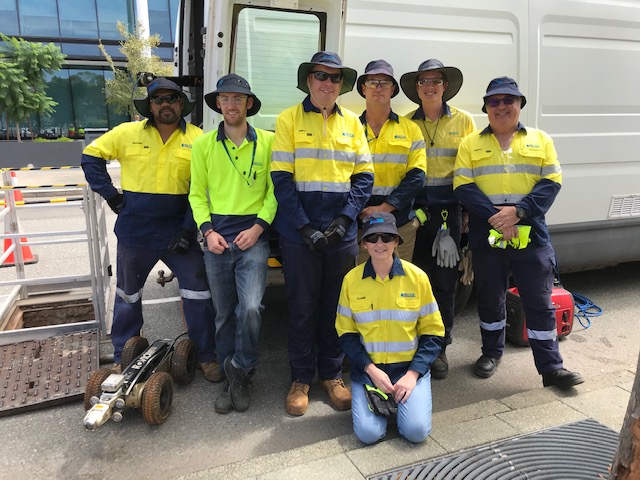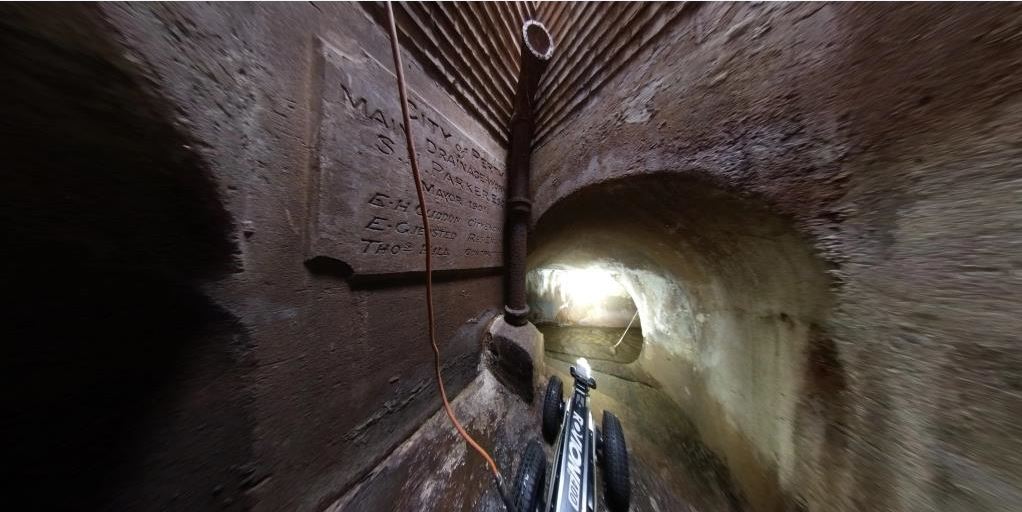Century old foundation stone found in the East Perth drainage network
A foundation stone dating back to 1901 has been discovered 5 metres below ground in the East Perth drainage network, confirming rumours that have circulated among Water Corporation employees for over 30 years.
The relic was discovered by our Inspection and Condition Assessment team during recent inspections of our drains in the area. For health and safety reasons, robotic Remote Operating Vehicles (ROVs) fitted with high-resolution cameras are used to assess and record this subterranean maze, enabling the pilots on the surface to receive a real-time video feed. Recordings are also then used for further assessment and investigation.

(Left to right): Trainee ROV Pilot Graham Jetta, Engineering Manager Callan Wood, ROV Pilot Matthew Hallmark, ROV Team Lead Brad Priddis, Engineering Manager Glenn Richardson, Senior Engineer Perry Beor with Media and Strategic Communications Manager Clare Lugar kneeling in front on the day the 1901 foundation stone was discovered.
There was a sense of disbelief and excitement when the crew stumbled across the foundation stone, as it had been written off as something of an urban myth in Water Corporation circles.
The history of Perth’s drainage network
Despite being more than a century old, the stone, which is approximately 0.8 by 0.8 metres and made of cast mortar, is in good condition and clearly reads:
City of Perth
Main Drainage Works
S.H. Parker Esq.
Mayor 1901
E.H. Gliddon City Engineer
E. Gjedsted Resident Engineer
Thos Hill Contractor

Five metres underground, the 1901 foundation stone was a historical discovery of grand proportions by our team.
Although the foundation stone dates back to 1901, we did not take over responsibility for drainage until just before World War One, when we were known as the Metropolitan Water Supply, Sewerage and Drainage Department.
The drainage network was originally constructed by the City of Perth for £10,000 at the turn of the last century, partly in response to the typhoid epidemic in 1896-97 worsened by to water shortages at the time.
The original drainage network ran along Wellington Street and into Royal Street, discharging into Claisebrook, a stream that empties into Claisebrook Cove, before running into the Swan River.
Its purpose was to drain lakes Kingston and Irwin, which were located roughly where you find the Perth Railway Station and Yagan Square today. The drain was later rebuilt and extended in 1922 to protect the local area from flooding.
Perth’s drainage network today
We now manage 1,119 kilometres of drains in Perth out of 2,545 kilometres statewide. Regular inspections help to inform our maintenance and investment in the network.
We would like to pay homage to the former City of Perth Mayor, Sir Stephen Henry Parker, the two engineers Edgar Howard Gliddon and E. Gjedsted, and City contractor Thos (Thomas) Hill for their contribution more than a century ago for paving the way to today’s drainage infrastructure.